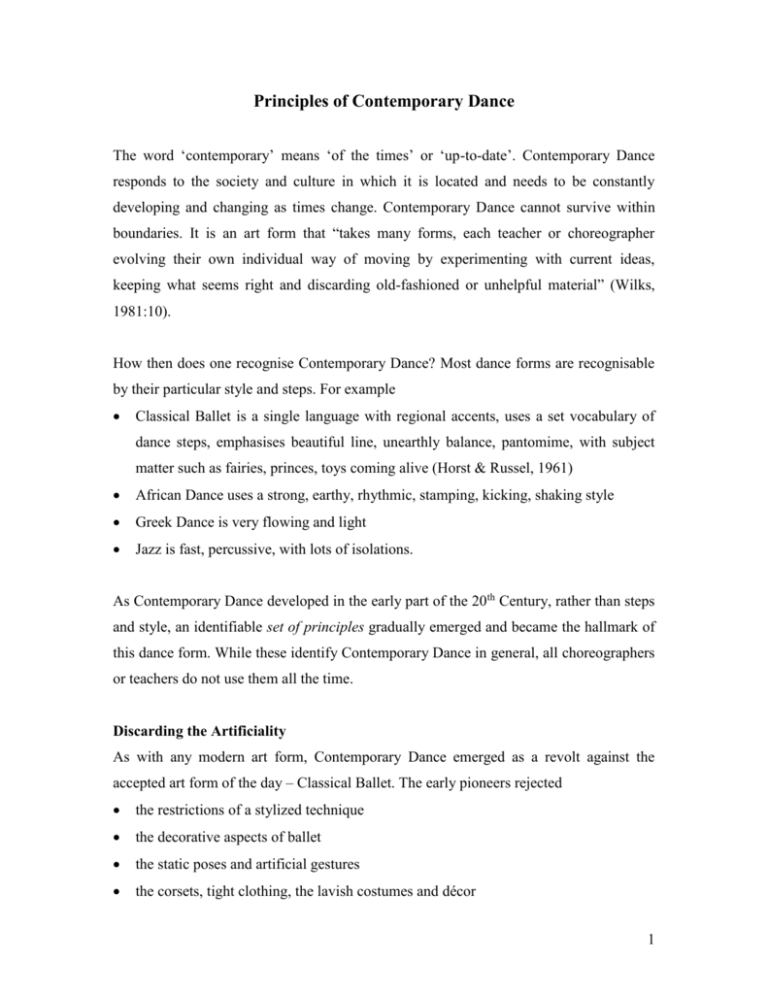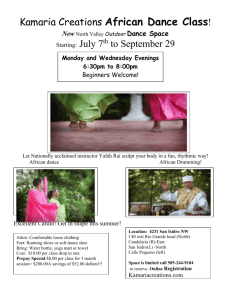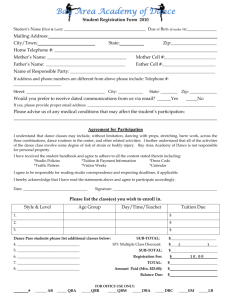Principles of Contemporary Dance
advertisement

Principles of Contemporary Dance The word ‘contemporary’ means ‘of the times’ or ‘up-to-date’. Contemporary Dance responds to the society and culture in which it is located and needs to be constantly developing and changing as times change. Contemporary Dance cannot survive within boundaries. It is an art form that “takes many forms, each teacher or choreographer evolving their own individual way of moving by experimenting with current ideas, keeping what seems right and discarding old-fashioned or unhelpful material” (Wilks, 1981:10). How then does one recognise Contemporary Dance? Most dance forms are recognisable by their particular style and steps. For example Classical Ballet is a single language with regional accents, uses a set vocabulary of dance steps, emphasises beautiful line, unearthly balance, pantomime, with subject matter such as fairies, princes, toys coming alive (Horst & Russel, 1961) African Dance uses a strong, earthy, rhythmic, stamping, kicking, shaking style Greek Dance is very flowing and light Jazz is fast, percussive, with lots of isolations. As Contemporary Dance developed in the early part of the 20th Century, rather than steps and style, an identifiable set of principles gradually emerged and became the hallmark of this dance form. While these identify Contemporary Dance in general, all choreographers or teachers do not use them all the time. Discarding the Artificiality As with any modern art form, Contemporary Dance emerged as a revolt against the accepted art form of the day – Classical Ballet. The early pioneers rejected the restrictions of a stylized technique the decorative aspects of ballet the static poses and artificial gestures the corsets, tight clothing, the lavish costumes and décor 1 the reality-escaping Pointe shoes in favour of feeling the feet in contact with the lifecharged earth the polished, glib, decorative and the superficial style or subject matter. They aimed to dig down to the essence of significant movement, to look for a way to express the energy and vitality through a freer but more direct form of movement (Wilks, 1981). They chose vibrant, strong, choreographic subject matter, sometimes communicating personal authentic experience. A contemporary dancer needs to also be a choreographer. Movement Quality Fundamentally the difference between Contemporary Dance and other forms of dance lies in the movement quality. The movement quality depends on the attitude towards movement and towards the body in space. These statements were made about Contemporary Dance by leading pioneers at various times: An art should be constantly changing; it must not remain static. It cannot have fixed rules It should be non-conformist and should not try to create a tradition It is experimental, eclectic and inclusive It is not representational (it does not try to copy life), it is imaginative It should stretch the personal vocabulary Movement needs to be significant not decorative The essence of movement lies in the transitions not in the position (Said by Isadora Duncan in Cohen,1986) Movement quality is everything Ever-changing style In Contemporary Dance, each choreographer forms a movement style tailor made for their own choreographic intentions. The technique is eclectic (a mixture borrowing from many influences) and involves a constant process of discovery and development with dancers encouraged to explore their own approaches to style. This expression of individuality is an essential ingredient of Contemporary Dance. 2 Training based on logic and safety. There are few inhibiting rules in the dance training other than basic, logical ones about placement, safety and injury prevention. The purpose of the training is to develop a comprehensive technique with which to train the body to fulfill the vision of a new beauty of human movement There are no particular rules about style or body design. Respect for the human body and ability to use it to its fullest capacity without abusing or distorting it is the main objective. Gender Equality Contemporary Dance generally supports equality between male and female dancers. The principles below are interrelated and work together. They are separated here merely to be able to explore their meanings. Centering: At the very essence of Contemporary Dance is the kinesiological truth – “that human movement starts in the spine and pelvis and not in the extremities – the legs and arms” Dancers need to find their centre (solar plexus) from which point the arms and legs work. Movement is easier to control from the centre and a strong centre allows for freedom of movement of extremities. The limbs - arms, legs, head and neck are used as extensions of the torso in space. Alignment Part of centering has to do with posture, which is the key to balance and reveals and produces feelings. Posture has to do with alignment, which is the placement of all the parts of the body in relationship to one another. Incorrect alignment – bad posture – puts a strain on the spine and hinders graceful and efficient movement. 3 Gravity This is one of the natural forces which influences movement. Gravity is “the force that holds you down on the earth”. If we give in to gravity we fall down. We have to resist gravity to keep standing and work hard against gravity to jump. (Wilks, 1981). Charles Weidman felt that elevation should be seen as a triumph against gravity. Doris Humphrey spoke of dance as “the movement of body through space from standing to lying, as it responded to the pull of gravity” .The thrill and drama came from the defiance of gravity, the moment of suspension when the body seemed to break free of its physical confines”… “the arc between two deaths” (in Lewis, 1984: 15) Breath Doris Humphrey was fascinated by the ebb and flow of breath and how it affects movement. She developed a sense of the body’s natural rhythms, the breath phrase, the breath rhythm and explored how fall and recovery occur in response to these rhythms. Through awareness of breath and gravity, she drew attention to principles of suspension the moment of suspension as the body is airborne and the moment the body falls or sinks to the earth. Contraction and release Martha Graham focused on the physiological effects of the act of breath – the ebb and flow of breathing and its effect on the torso as it expands and contracts and on the function of contraction and release in the muscles. Breathing co-ordinates breath and movement - brings oxygen, energy, fluency and harmony. Breathing is an expressive tool e.g. moving with a sense of breath brings a feeling of freedom and harmony. Graham discovered that contractions could be the source of powerful movement e.g. intensifying the dynamics of a contraction into a spin Fall and recovery The principle of fall and recovery combines breath, suspension and gravity. 4 “Fall” is the complete release of the muscles as the body gives in to gravity. A fall releases a vast amount of kinetic energy which can be harnessed by catching it in a recovery or a rebound which is then suspended. Recovery is the rebound of the energy passing though the bottom of the fall and continuing on the same path like a pendulum swing. Rebound uses elastic reaction of the muscles at the limit of their stretch to naturally spring back. The energy continues along the lines of centrifugal force. Suspension is a prolonged high point It is created at the peak of the movement by continuing the movement and delaying the takeover of gravity. The combination of the weight of the head in the fall, the elasticity of the spine and the release in the knees creates the feeling of rebound throughout the body. Balance and Off-Balance Inner balance relies upon an awareness of weight and pressure. In order to stand upright we have to have our weight over our feet otherwise gravity will cause us to topple over. The part of the body where the weight is centered is called the “centre of gravity” which is inside the body at hip height (the pelvis). When displacing the pelvis the body will go off-balance as in a tilt or in fall and recovery. Using off-balance movements gives a sense of urgency, vitality or danger Tension and relaxation Muscles tense and relax to enable us to stand and move. Tension and relaxation also express how we feel. All movement exists between the two opposite poles - absolute tension – so tense you cannot move - to absolute relaxation – so relaxed you cannot move. Opposition Opposition implies two things working one against the other. These things may be forces, parts of the body or people. Opposition is a way of using the entire body to create the feeling of length and stretch in a movement, without tensing or gripping (shortening) the 5 muscles. The human body has 5 points of opposition: the head, left and right hand left and right leg. Each can oppose the other to get stretch and length in the arms and legs and to feel the connection of the one to the other Succession Succession is the opposite of opposition. It is a sequential path of movement through parts of the body – a wave-like reaction i.e. body parts go in the same direction rather than in opposite directions. Spiral This is the turn of the body on its axis (around the spine). It is used for balance, control and turning. Swings and Momentum Swinging movements, like a pendulum, depend on the force of gravity. The down swing gives in to gravity but the momentum gained as it falls causes it to swing up again. There is a moment of suspension at the end of the swing before gravity causes it to fall again. Sometimes it is easier to describe something elusive by comparing it with something else. For instance Classical Ballet Contemporary Dance celebrates flight is interested in the floor kept the upper body rigid uses greater flexibility of the torso movement is stylized uses everyday movements creatively or invents radical movement vocabulary style tends to be unreal and ethereal is intrinsic dance – basic, essential, organic, internal - people can relate to and identify with it may appear free of all gravitational pull, acknowledges movements seem devoid of effort. and emphasises that movement is generated by the effort to resist the magnetic pull of gravity, to 6 oppose its energy denies tension exploits tension fully Emphasises awareness of line, speed, abstracts and extends familiar movement balance, dramatic portrayal of role References Cohan, R. (1986) The Dance Workshop, Unwin Paperbacks: London Selma J Cohen, Editor, (1965) The Modern Dance Seven Statements of Belief. Wesleyan University Press, Connecticut Horst, L & Russel C (1961) Modern Dance Forms in Relation to the Other Modern Arts Dance Horizons: New York Lewis, D. (1984) The Illustrated Dance Technique of Josè Limon. Harper & Row: New York McDonagh, D. (1970) The Rise And Fall And Rise Of Modern Dance. Sunrise Books: New York Wilks, J. (1981) Better Contemporary Dance. Kaye & Ward: London. Compiled by Jennifer van Papendorp Principal Subject Advisor: Dance 22/05/2001 7







